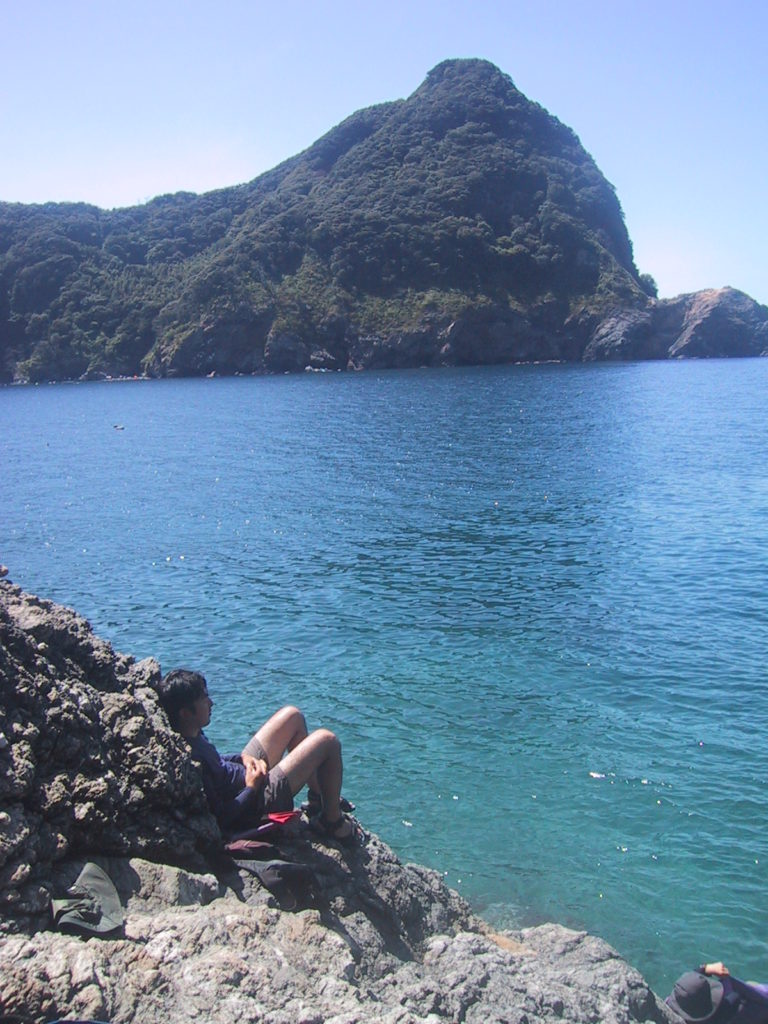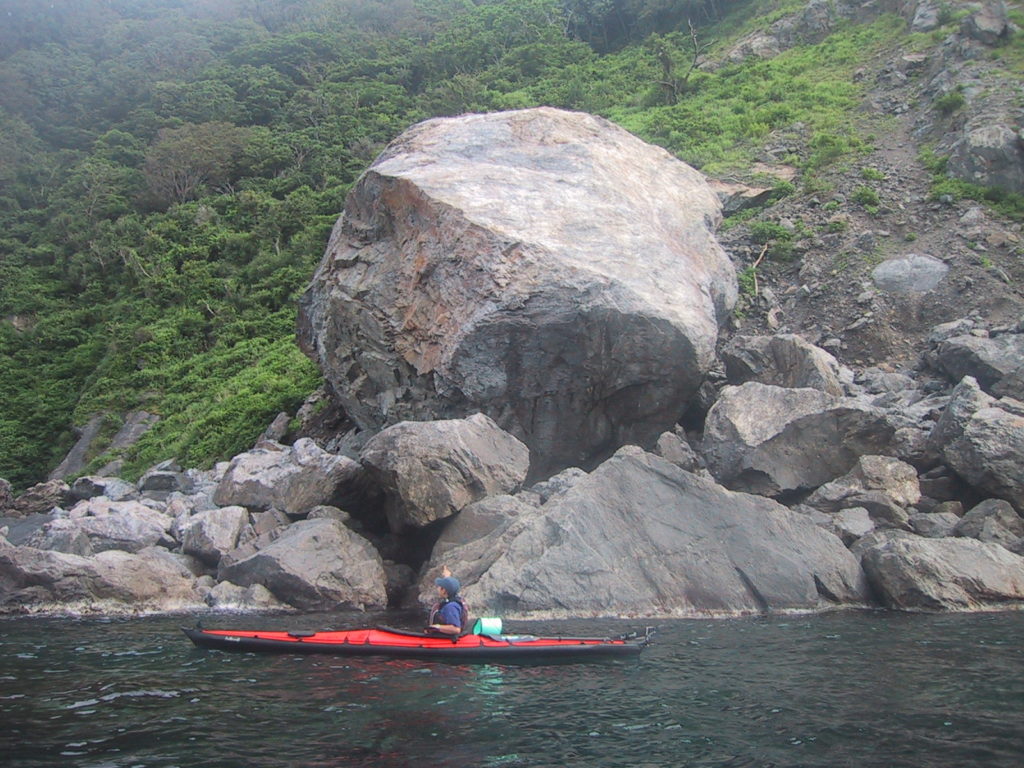When you reach the tiny village of Tsunekami, at the tip of the peninsula of the same name, you literally come to the end of the road. To reach this place, you must first drive along a winding, rocky coast that sometimes rises high above the ocean, affording spectacular views of the bay, jutting peninsulas and the many islands off in the distance. You will pass by a handful of tiny fishing/tourist towns right on the water until the road makes one last turn along a sheltered bay before entering a tunnel and emerging in Tsunekami. You’ll see the local temple on your right and a few hotels and houses tucked into a fold in the mountain. It feels like coming to the end of the earth and, in a sense, it is. There is no more Japan to the north and west, and the only way to go farther is by boat—but, then, that’s what we’re here to do.

Much of the Japan Sea coastline is long stretches of sand, ideal for sunbathers, strollers and surf fisherman. Fukui’s Wakasa Bay breaks the smooth lines of Honshu’s backbone with twisting, rocky lines, inlets and bays, islands, arches and points. Because there are no major rivers feeding into it, the bay is amazingly clean and clear; perfect for sea kayaking.
Our destination is the Atarashiya Ryokan, run by the friendly Shintani family. Fishing and tourism are the two main occupations here, and the Shintanis cover both.
The missus runs the hotel with the grandparents, while husband and son tend the nets and the tiny local fish wharf in the mornings, ferry guests to sheltered beaches in the summer season and prepare the mounds of incredibly fresh fish that make up most of the meals, as we’ll soon discover.
Our guide and host, Shiro Ose, arrives in a well-worn van stacked high with sleek kayaks. He looks as if he was made to paddle, with a rugby player’s build, a straw hat perched atop a tangle of hair, a deep tan and eyes that look out toward the horizon.
With him is Hiromichi Kuga, a tall, smiling man who helps Shiro with his kayak business in the summer, is a telemark skiing instructor and guide in the winter and also a trained Zen priest and apparently the heir to a temple a little farther inland in Fukui. It is not the last contact we will have with Zen priests on the trip.

‘Back to the Future’
Modern sea kayaks echo the ancient lines of the skin-on-wood-frame boats used in the Arctic regions from Greenland to Alaska, but now most are molded plastic, fiberglass, Kevlar or carbon graphite. Our boats on this day are truer to the old ways, although with modern materials.
They have a framework of light aluminum tubes, assembled and inserted into a tough synthetic skin, tightened, then completed by inflating a series of tubes that run the length of the boat’s sides. This breakdown style not only gives the boats a flexibility in the waves that is more like the original, but also means the roughly five-meter-long, 18- to-25-kilogram kayaks, disassembled, fit into an oversized backpack, and then very nicely into the trunk of a car.

Paddling Priests
Since it’s almost sunset, we check in with the ryokan, then go to the local temple to meet Tsugen, the town priest. He’s a friendly man who keeps a sea kayak of his own tucked into a corner behind the temple residence, taking it out on perfectly calm days to paddle from the tiny swimming beach just across the quiet road, often accompanied by the local kids.
He’s concerned about the waves rolling between the tip of Tsunekami and Mikamijima, a tall, steep-walled island less than a kilometer offshore. “I never paddle when there are waves,” he says, surprised we actually find them (at some sizes) fun.

Returning to Atarashiya, we find a table covered with seafood, topped off by a squid so fresh its skin still pulses with colors. Over some cold beer and good food, I discover there are in fact Japanese who know how to take it easy; our conversation over the next few days’ plans is completely devoid of minute scheduling and detailed planning. We go over some options—and there are many—and decide to see how the waves are in the morning.
Waveriding
The waves are still there the next day, but we decide to head out toward the channel between the peninsula and the island, then head into open water and go east to the port of Hayase. At least that’s the original plan; Tsugen says goodbye as we head out, but we soon find the waves past the point are big enough to make photographer Shinju Horikawa’s eyes open very wide.
Shiro turns us back south, and we instead ride the waves across the bay, passing unmanned Ube Island, before settling on a pebbled beach for a sunny lunch and snooze. (As I said, these guys know how to relax.)
The return is a leisurely paddle past tiny pine tree-topped islands and through rock gardens, formations that just barely allow a sea kayak to pass. Drawing only a few centimeters, the kayaks are ideal for exploring these tiny gaps, some which require a little careful timing of the waves to make sure there’s enough water for passage.
With the day running out, we stop at a small beach town along the way; Shiro and Hiromichi take the bus to go get the van to pick us up and the boats. They return in 30 minutes looking a bit rattled. “Tsugen-san got worried when he saw the waves getting bigger,” Shiro says. “He didn’t see us turn back, so he called a fisherman over in Hayase to start looking for us. They’ve had boats out searching for us all afternoon.”
We hurry back; Shiro shuttles off to the temple. Lots of phone calls are made, and, we all head over to apologize to our concerned priest (and have some saké to secure the relations). Eventually everybody is relaxed and ready to go again.
Obama and Nuclear Power Plants
The next few days are uneventful as we take in some of the many possibilities of the area. First we head across the bay past the now-famous town of Obama to Takahama, where we launch from a sandy beach and head across the bay to a beautiful, deeply wooded and rocky coast that hides the Takahama Nuclear Power Plant just behind the hills.
The warm water outlet from the plant is here, drawing fish and therefore fishermen and fishing birds. There’s a lot of wildlife around, but it is also a slightly spooky reminder this area of Fukui is home to a large number of nuclear power plants, and signs indicating evacuation spots are never far away.
On the final day we have a leisurely paddle through the five lakes of Mikatagoko, starting in freshwater Mikatako then passing through Suigetsuko, the shady, manmade Uramigawa canal (with stunning 60-meter-tall cliffs on either side) and into brackish Kugushiko.
Again, the low sea kayaks are a great way to see the changing scenery and feel part of the water; the only distractions are the tourist jet boats that scream by on a regular schedule and force a wait at a canal-side traffic signal before we can pass through the Uramigawa.
There is much more in the area, as I discover on further trips: sea arches and caves around Mikamijima, islands farther out in the bay for a more adventurous crossing, hidden beaches where snorkeling can be interrupted by a troop of monkeys caught rummaging through the kayaks.

Much of it is only accessible by kayaks, in fact, making the vessels one of the best ways to access Wakasa—and anyone can master them well enough in a day for safe exploration of this beautiful area, particularly with a good guide to show you how to paddle, relax and enjoy.

WAKASA ESSENTIALS
Getting to Wakasa
Tsunekami is a good choice for paddling the east coast of Wakasa Bay, perhaps the most varied part of the region, with a wide range of ocean shoreline and the Mikatagoko lakes. It’s also a bit of a journey to get to, with private cars (or a guide) the easiest way to access the peninsula.
Access (Car): Hokuriku Expressway to Tsuruga IC; Route 27/Kaneyama Bypass south. For Tsunekami, turn right on Route 162 and continue to the end of the road. For other areas, continue west on Route 27. (Train): By Shinkansen to Maibara; Hokiriku Honsen to Tsuruga; Obama Line to Mikata Station and bus or car to Tsunekami. For other area destinations, use either Mikata Station or Kaminaka Station of the Obama Line.
Atarashiya
Typical friendly minshuku style accommodation; big seafood meals. Larger groups may want to request the Annex, which is high on the hill above the beach area with excellent ocean views and morning access for paddling.
Address: Tsunekami, Mikata-cho, Mikata-gun, Fukui-ken 919-1451
Tel: (0770) 47-1120; E-mail atarashiya@am.wakwak.com; Web: http://park6.wakwak.com/~atarashiya/
Pamco
Another good alternative in the area, particularly for those who would prefer to start on the Mikata lakes (and avoid the long, winding road to the end of the peninsula). A modern, airy hotel; good seafood and locally-brewed beer on tap.
Address: 64-9-1 Umiyama, Wakasa-cho, Kaminaka-gun, Fukui-ken 919-1461
Tel: 070-47-1727; E-mail: info@pamco-net.com; Web: www.pamco-net.com/index.html
Granstream
Based in a refurbished 100-year-old farmhouse on the west coast of Lake Biwa, Shiro Ose sells Feathercraft folding kayaks and a full range of accessories. He also provides kayak instruction on the lake as well as in the Wakasa Bay area, and runs a range of tours, both scheduled and by request (he is planning to offer English-language tours this summer as well).
Address: 605 Kaizu, Makino-cho, Takashima-shi, Shiga-ken 520-1811
Tel: (074) 20-2620 / 090-9371-3625; E-mail: ose@granstream.com, Web: http://granstream.jp/




